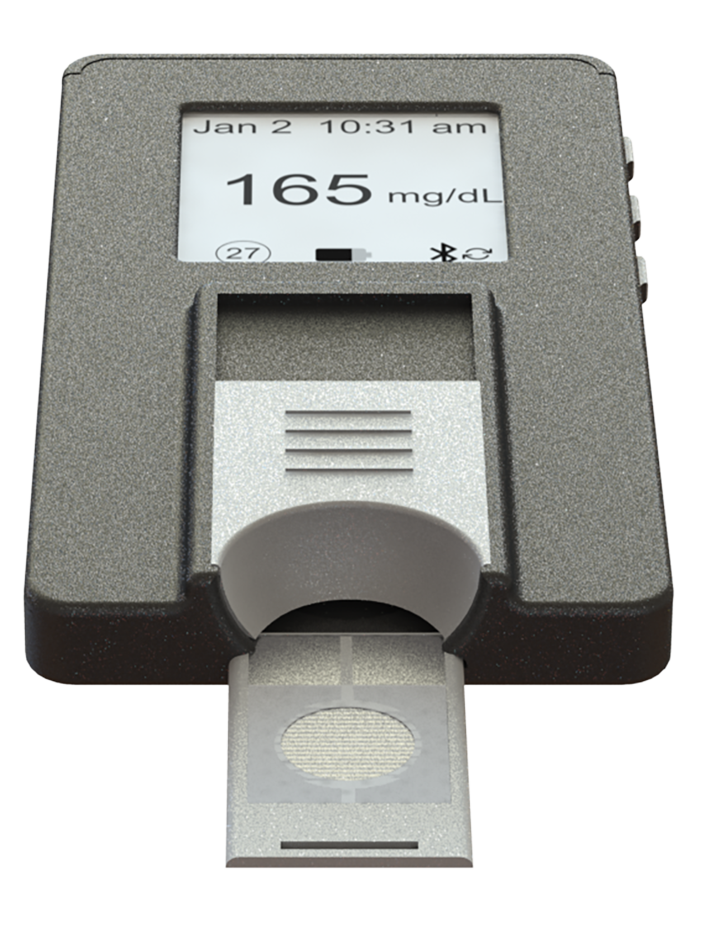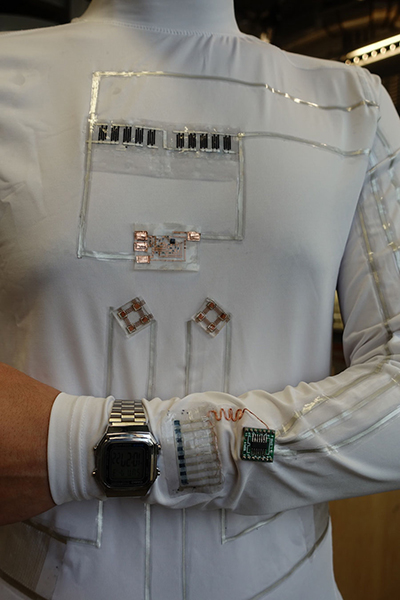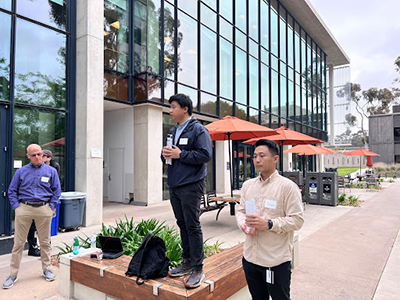Startup Developing Noninvasive Glucose Test Nets $4M in Seed Funding
The UC San Diego spinoff company is led by engineering alumni
Story by:
Published Date
Story by:
Topics covered:
Share This:
Article Content
A startup spun off from technology developed at the University of California San Diego Jacobs School of Engineering has secured $4 million in venture capital seed funding to commercialize their sweat-based diagnostic platform technology. Their initial product, a noninvasive glucose test, uses the omnipresent sweat on fingertips to measure glucose level, potentially removing the need for people with diabetes to use painful finger pricks.
Persperion, led by Jacobs School alumni Lu Yin (nanoengineering BS ‘17 PhD ‘22) and Alan Liu (nanoengineering BS ‘19, MS in Management from Duke) licensed technology developed in Professor Joseph Wang’s nanoengineering lab that can detect a variety of biomarkers through sweat. Researchers in the lab, including Yin, designed a sensor that uses the trace amounts of sweat always present on fingertips– the sweat that leaves fingerprint smudges behind, no exercise required– and a proprietary enzyme interaction to accurately detect biomarkers in the user’s blood, including alcohol, hormones, metabolites, drugs, and yes, glucose.
They’re first planning to use this technology to alleviate painful finger pricks for diabetics.
“We believe that this is a platform technology,” said Yin. “We had this technology and tried to figure out how we can best utilize it to help people and make an impact. Among all the biomarkers we can test through fingertip sweat, we selected glucose as our first step because the need is so big.”
Users would insert the test strip inside a small handheld device, and then place their finger on the strip for tens of seconds to obtain a glucose measurement. A finger prick is needed for the first use to calibrate the system to that individual user, but no additional finger pricks are required. After 30 seconds, the device would read out the glucose measurement, and then stores the user’s historical data. Each test strip can be reused a few dozen times, until the enzyme is deactivated.
Yin and Liu are clear that this wouldn’t necessarily replace continuous glucose monitoring, but rather reach the tens of millions of diabetics in the United States who do not use or have access to continuous glucose monitoring for a variety of reasons. Many of these people still use blood from finger pricks, sometimes several a day, to measure their glucose levels. This sweat sensor would be a pain free and cost effective replacement to finger pricks.
The team has conducted initial trials, and found that their sweat sensor’s accuracy– 7.2% mean absolute relative difference (MARD) compared to blood-derived levels– is actually more accurate than published data from continuous glucose monitoring companies, which derive their measurements from the interstitial fluid between cells just under the skin. They are working with the Altman Clinical and Translational Research Institute at UC San Diego on a feasibility clinical trial to further study the device’s accuracy, reliability, and ease of use, before moving on to FDA clinical trials.
Liu and Yin are optimistic, but not foolhardy.
“Noninvasive glucose monitoring is the holy grail of glucose monitoring,” said Liu. “It’s been attempted for decades and no one has ever succeeded. We really believe this could be it. But while we’re ambitious, we’re also not too proud to think that the first product we ever bring to market will be a blockbuster. We want to start small and start with the basics.”
They were included in the 2024 Forbes 30 Under 30 list in the Science category for this groundbreaking work.


Scaling what’s possible
As students in Wang’s lab in the Department of NanoEngineering at UC San Diego, Yin participated in groundbreaking technology developments including using sweat to power electronics; a wearable ultrasound sensor for cardiac imaging; and earbuds to record brain activity. Yin co-authored more than 40 papers during his tenure in the lab as an undergraduate, graduate student and postdoctoral scholar. So what made them decide that this particular innovation was worth commercializing?
“A lot of research we do in the lab is at the frontier– trying to push boundaries and demonstrate what’s possible,” said Yin. “When we’re talking about commercializing technology, less is more. All of my research has been trying to make things a little bit more practical than they originally were, even though most of the time they are still miles away. But this one…it doesn't require a million things to work at the same time. It can be fabricated very cheaply. And we actually have amazing data to back this to show that the tech works across a diverse group of people. So that’s when we started thinking this might be the chance.”
Persperion, which now has five full time employees including Yin and Liu, had been operating out of the UC San Diego Design and Innovation Building for one year. With their seed funding, they moved to a hybrid lab and office space in Kearny Mesa in October to continue improving and testing their prototype, and begin to scale up manufacturing for clinical trials.
“Everything hinges on how sensor development goes,” said Yin. “We’re tackling some issues such as the shelf life of the test strip–we want it to be able to stay in a warehouse for a year and still function properly. We want to make sure it’s accurate even when testing at high altitude or at extreme temperatures. In addition, we’re trying to shorten the time needed to press your finger on the sensor down from 30 seconds. Finally, we’re exploring ways to eliminate the need for finger prick calibration.”

An entrepreneurial ecosystem
Yin and Liu started their entrepreneurial journey at UC San Diego nearly a decade ago as undergraduate researchers in Wang’s lab. Their graduate student mentor, Rajan Kumar, founded battery startup Ateios, and the pair joined the Ateios team and got first-hand experience building a company from scratch. Ateios, also spun out from technology developed at the UC San Diego Jacobs School of Engineering, now produces batteries using an innovative electrode manufacturing technique that increases the speed and decreases the carbon footprint of battery manufacturing. This experience planted a seed for Liu and Yin.
After deciding to found Persperion and commercialize this sweat sensing technology, they received substantial help from the UC San Diego Institute for the Global Entrepreneur, getting training in entrepreneurship in the Institute’s MedTech Accelerator and the NSF I-Corps program. They also got access to Institute for the Global Entrepreneur mentors including Todd Hylton, Ph.D., who is a Type 1 diabetic himself.
“Persperion is a great illustration of what can happen when we align the unique assets of UC San Diego – hard-working student entrepreneurs, world-renowned research labs, and entrepreneurship resources,” said Hylton, an Institute for the Global Entrepreneur Research Translation & Acceleration Program Officer. "As a Type1 diabetic for 46 years, I was initially quite skeptical about Lu and Alan's claim that they might finally deliver the dream of non-invasive glucose testing, but one trip to their lab changed my mind. Since then we have worked closely to put together the story, the team, and the capital to launch Persperion. I hope that their journey is an inspiration to many other young entrepreneurs at UC San Diego.”
The Institute for the Global Entrepreneur at UC San Diego is a collaboration between the Jacobs School of Engineering and Rady School of Management, with a mission to educate, train and empower engineers to become changemakers and technical leaders who are prepared to drive innovation and advance research from the lab to the marketplace.
Persperion was also supported by the Office of Innovation and Commercialization, which helped Yin and Liu license the technology and start developing it in designated startup space in the Design and Innovation Building. They also provided early funding through the Accelerating Innovation to Market grant.
“We were provided a lot of resources, connections, and a lot of introductions through UC San Diego,” said Liu. “Everyone wants to help–we are really glad to be in this ecosystem. All of these players act together to bring us to where we are today. When we first started we just had a technology. We really didn't have a very comprehensive understanding of the business, customers, or market. These programs and mentors really pushed us to gain that understanding.”
You May Also Like
UC San Diego is Strengthening U.S. Semiconductor Innovation and Workforce Development
Technology & EngineeringStay in the Know
Keep up with all the latest from UC San Diego. Subscribe to the newsletter today.




